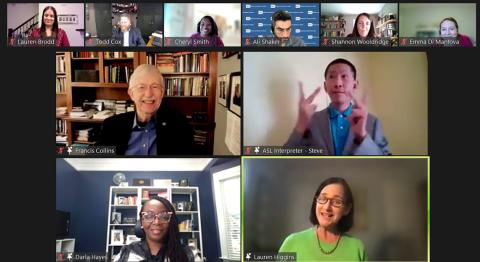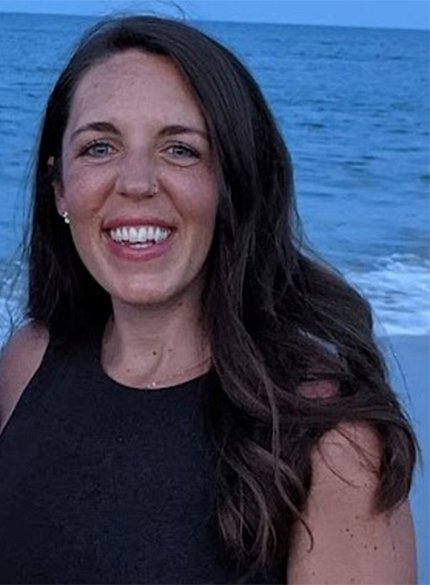Going the Extra Mile…or 3
Collins Thanks IMOD, CIT

“You’ve always gone the extra mile. And I know sometimes I’ve asked for 2 or 3 extra miles!” then-director Dr. Francis Collins told employees of IMOD (the Immediate Office of the Director) and CIT (Center for Information Technology) in a Dec. 8 Gratitude Tour stop.
“I could have never been able to do the job I was called to do without the kind of support you have given me.”
IMOD duties include central oversight on NIH activities in research funding, management, administration and information technology. As many NIH staff members know, CIT provides both the NIH and external collaborators with IT support and has been absolutely integral to the shift to remote work. Both Collins and his wife, Diane Baker, thanked IMOD and CIT for their hard work in supporting both the director’s office and the other ICs.
The tour, Collins said, was “only scratching the surface” of what IMOD and CIT have accomplished the past 21 months, “but what a scratching it is!”
From developing and leading the RADx (Rapid Acceleration of Diagnostics) for the Covid-19 pandemic, to processing hundreds of media requests, to managing a 400 percent surge in online meeting requests, and so much more, IMOD and CIT have done so much that deserves recognition.

Darla Hayes, associate director for management/executive officer for the Office of the Director, welcomed Collins and Baker and took a moment to acknowledge the former’s upcoming departure from the top job.
“I have always been extremely proud to be an NIH employee. But these last 2 years have multiplied that pride,” said Hayes. “Thank you for inspiring us, entertaining us, caring about us.”
Several employee speakers were featured in the Gratitude Tour stop.

Shannon Wooldridge is a policy analyst with the Executive Secretariat and the manager of Collins’s “incredibly busy inbox.” The colloquially named “ExecSec” was largely paper-based before the start of the pandemic, Wooldridge revealed, and “almost overnight, we pivoted from a 100 percent paper-based signature and clearance system to one that is nearly 100 percent electronic.”
Managing Collins’ email was also a feat in and of itself. “We had to manage your inbox 7 days a week just to keep up with you,” Wooldridge added, while also handling Covid-19 clearances from HHS, CDC, FDA and the White House and triaging more than 5,000 pandemic inquiries from the public.
“Those of us who have access to your calendar and email could never complain about the extra hours we were working,” she said to Collins. “We saw your dedication firsthand.”

Richard Barnes, the senior web designer with the Online Information Branch of NIH’s Office of Communications and Public Liaison, recalled that the World Wide Web did not exist when he first started working at NIH. But the internet, and especially telework, he argued, allow for more effective collaboration.
He also emphasized the impact of the various NIH websites managed by his branch: “Before the pandemic, the nih.gov website was averaging 52,000 page views a day. Mar. 18, 2020, page views surged to 630,000.” The NIH employee intranet saw a similar increase, from 1,500 daily page views to 34,000.
The NIH website is “our window to the world,” Collins added, and “the world is really interested, especially right now.”

Dr. Cheryl Smith, a health science policy analyst, recalled her introduction to the Office of Science Policy. Her first major assignment on joining NIH in 2016 was to create a resource that kept the Lacks family informed about how genomic data from HeLa cells are used in biomedical research. “It went from a 100-page document into [an accessible] website,” Smith shared. “It’s entertaining, it’s updatable, a truly living document.”
The website that Smith helped develop was in support of the 2013 NIH-Lacks Family Agreement between NIH and the descendants of Henrietta Lacks whose cervical cancer cells became the first human cells to grow continuously in culture (HeLa cells). The NIH-Lacks Family Agreement is a special process for making HeLa cell sequence data available for biomedical research while respecting the family’s privacy and interests. Like the agreement that preceded her work, Smith commented that she was “bringing participants’ voices to the table where their voices matter…that’s not only a treasure to [the] family, but to the public.”

Todd Cox, a service area manager for Unified Communications and Collaboration at CIT, spoke next.
In addition to managing the massive surge in online meeting requests, CIT also had to figure out how to host meetings with thousands of participants. The very first virtual town hall, organized by the NIH Office of Communications and Public Liaison and supported by CIT, went down as one of the most impressive accomplishments. CIT had never managed the IT hosting of a live town hall before, Cox recalled.
“We were sitting there in that room [in Wilson Hall], and we were just praying that it did not glitch or fail because we had well over 23,000 people watching.”
That first town hall was a success, of course, as have been the many that have followed. “I think our example may have encouraged other parts of HHS,” Collins observed.
The final speaker was Lauren Higgins, deputy director of the Office of Legislative Policy & Analysis (OLPA). Her office serves as an intermediary between NIH and Congress. Some of OLPA’s many duties include assisting the NIH director to appear before members of Congress and provide testimony at congressional hearings.
“There are two things that Francis Collins loves, and they don’t go together: technology and Congress,” Higgins laughed.
Congressional hearing rooms couldn’t support the kinds of presentations that Collins wanted to use while testifying before congressional committees at the beginning of his tenure, she said, but they adapted over the years. As time went on, Higgins said, “the [congressional] committees not only adapted to what your technology needs were, [but] enjoyed your visuals and raved about them.”
Transitioning to Zoom was its own challenge, and although OLPA worked with the committee staff, they couldn’t always use the visuals during virtual hearings, but Collins “took it all in stride,” according to Higgins.
“We have a great story to tell…and you all helped me do that,” Collins said.
Baker spoke at the end of the tour: “You…support Francis and he could not do what he does without the backbone, the intellect, the passion and the commitment that you all have to make this happen.”
The next NIH director will be “darn lucky,” Collins said, closing the tour. “Public service is just an incredible opportunity to have a life that means something, and I think that’s what we’re all looking for.”
